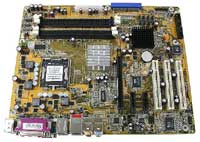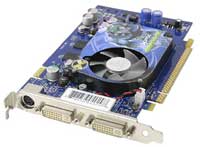Gaming Buyer's Guide - November 2004
by Jarred Walton on November 21, 2004 5:54 PM EST- Posted in
- Guides
Intel Budget Gaming System
At the lowest end of the spectrum, AMD doesn't have quite as much of an advantage in performance over Intel, since the CPU is less of a bottleneck, and there is one item that Intel can offer which AMD cannot (yet): PCI Express. Suffice it to say that especially for die-hard Intel fans, they are not a terrible choice, although they do cost slightly more. Here is our best attempt at matching the Budget AMD system's price and performance.| Budget Intel Pentium 4 System | ||
| Hardware | Recommended Component | Price |
| Processor | Pentium 4 520 2.8 GHz 1MB Cache | 158 |
| Motherboard | DFI 915P-TAG i915P | 118 |
| Memory | 1x512MB Mushkin Basic 2.5-4-4 | 75 |
| Video Card | XFX GeFORCE 6600GT 128 MB | 178 |
| Hard Drive | Seagate Barracuda 80GB EIDE model 7200.7 | 59 |
| Optical Drive | NEC DVD+/-RW Drive Model 3500A | 72 |
| Case and Power Supply | Athenatech A602 Black/Silver with 350W PSU | 62 |
| Display | Samsung 793DF 17 Black/Silver CRT (1280x1024@75 Hz) | 139 |
| Speakers | Logitech Z-640 5.1 | 52 |
| Keyboard and Mouse | Logitech Optical Desktop Combo | 26 |
| Bottom Line | 939 | |
 Click to enlarge. |
 Click to enlarge. |
Another drawback is that dual-channel RAM helps the Pentium 4 more than it does the Athlon 64, so using only one DIMM is going to cut into that performance boost a bit. If you plan on adding 512MB of RAM in the near future, that's not too big of a problem. Otherwise - and we hesitate to say this as they may not be of much use in future systems - using two 256 MB DIMMs will cost about the same as a single 512 MB DIMM. The extra $70 or so spent on an Intel system could be put into other items like a better graphics card or a faster CPU, and AMD also has the 64-bit factor to consider. This is why we still give AMD our primary recommendation, but it really is a close match-up in this price bracket.
Besides shipping PCI Express support, Intel also has their HyperThreading feature, which can help in certain multi-tasking applications. We have not yet seen any performance benefit to HyperThreading in the gaming realm - quite the reverse, in fact, as most games run a few percent slower with HTT enabled - but that could change in the future. With both AMD and Intel shifting away from increasing clock speeds to multi-core designs, it would make sense that games at some point will need to shift to a multi-threaded programming environment in order to extract the most performance from the processor. HTT ends up being nothing that we are overly concerned with as far as games go, but it's still there and it could come into play in the next year or two.
If you feel that our budget recommendations are almost impractical, just take that as an indication of the difficulty of selecting parts for this price segment. These three platforms are all very capable, however, and none of them is truly a bad choice. If you're the type of person who upgrades parts frequently - i.e. more than twice a year - over the life of your system, the socket 939 and socket 775 platforms will be a better choice. From a pure price standpoint, socket 754 still wins out.










70 Comments
View All Comments
SDA - Wednesday, December 1, 2004 - link
Whoops, I'd forgotten all about this thread.400W is fine if that's what you want, since it's your system. I wouldn't recommend to others that they spend much more for a 400W PSU (as opposed to spending more to get a higher-quality 350W or 380W PSU) when the average high-end Athlon 64 rig consumes 230W or so under load, though. I'd define 50% more than is necessary under full load "moderate," how about you?
520W is still overkill for SLI 6800GTs on an A64, although not as bad as 400W is overkill for the average A64. As I recall, SLI 6800Us on a high-end A64 eat something like 350W of power (decked out with HDDs and fans and whatnot, of course). 470W is perfectly fine there (although I'd personally just get a Tagan 480W, which should be the same and cheaper + less gaudy to boot). Again, you're welcome to do what you want, but you have an obligation to research system power consumption before you make recommendations to others.
As for E-Power/Tagan, the amperages really aren't very different. Furthermore, just because they don't look the same doesn't mean they're not. They use very similar components, have an identical layout, and use the same PCB. Trust me, PCB and components say a lot more than paint job ;) Googling Tagan and PowerStream should give you some nice solid evidence (and juicy internals pics!).
Again, nothing against the guide in general.. I just ask that you research the subject more in the future.
JarredWalton - Friday, November 26, 2004 - link
"Moderate PSU" in my book means >=400W these days. If a 350W generic PSU isn't sufficient, are you really going to want to spend $25 to $30 (shipped) for something that is the same wattage but more reliable? Maybe, but I wouldn't. If I buy an add-in PSU, I'll get at least a 400W.520W *is* overkill for most systems, but if you look at what I said it makes sense. If you want SLI with two 6800 GT or 6800 Ultra cards, you're probably going to have two (or more) hard drives and a lot of other stuff as well. I would spend the extra money for the 520W in that case. Regarding the OCZ = Tagan comment, I would have to see some really concrete evidence of that. Judging by The Egg, they're not the same:
http://www.newegg.com/app/viewProductDesc.asp?desc...
http://www.newegg.com/app/viewproductdesc.asp?desc...
The E-Power/Tagan has very different amperages than the OCZ. The shells are also different. Both are quality power supplies, of course, but even if they share some common components, that doesn't make them "the same."
Anyway, the PSU comments are duly noted and I will make sure to mention this item more clearly in the future. Please move on from the PSU comments now... nothing to see here. ;) (If you really want to comment more on the PSUs, you can. I'm only kidding people.)
SDA - Wednesday, November 24, 2004 - link
First thing to say: I don't want to sound insulting or condescending in any way. I think this is a good guide, and it's a lot of work to get a guide that a lot of people agree on as being good-- especially one as extensive as this.Now then. No, a good PSU will NOT add $50+ to the total for the budget systems. Fortron/Sparkle and TTGI power supplies are known to be solid units, if not amazing, and ones of appropriate wattage (300-350 is fine for a PC like the budget box) can be obtained for a reasonable $20-25 new. Is paying an extra 2.5~3% to avoid seeing a cheap POS PSU fail in an amusing fashion (possibly taking parts with it, I saw a Powmax unit take out an XP and mobo) and/or avoid instability worth it? Well, sure, I think so. Would you be willing to save $20 and go with cheap generic memory? Didn't think so.
And yeah, I realize the budget systems aren't meant for overclocking. That doesn't matter. I've been to the AMD official processor support forums too, and I've also worked as a tech support (paid and all, although FWIW a lot of the people that help out on those forums know what they're talking about more than pro tech supports), and I can say for certain that the biggest problem with DIY systems is cheap power supplies. They can be problematic even at stock clock speeds, and it's certainly not as if the budget systems are little old P2s that'll barely eat any power at all.
I'd also like to add, for the sake of balance, that 520W is overkill. Quality > quantity; you don't need a 450W PSU to achieve stability, not even if you're running an insane system. Oh yeah, and OCZ PowerStreams are the same as Tagans, and you can get those for pretty cheap (480W Tagan = ~$80 at the Egg of New).
JarredWalton - Wednesday, November 24, 2004 - link
54: The OCZ PowerStream is undoubtedly a good PSU, particularly for overclocking. That wasn't a primary concern with this Guide, so I didn't mention it as we have repeated that recommendation quite a few times. It's about $140 which is quite a lot for a power supply. On the other hand, for those seriously considering SLI with 6800 GT or Ultra cards, a power supply of that quality would be almost required.PseudoKnight - Wednesday, November 24, 2004 - link
Jarred, try the Logitech MX310. It has the Button4 and 5 on opposite sides like you prefer. (as I do, that's why I got one)Precise - Wednesday, November 24, 2004 - link
In your Oct. 1st Athlon 64 Memory: Rewriting the Rules review Wesley Fink stated:"We found that replacing a well-respected 465 watt PS with a 520 watt PowerStream allowed even higher memory overclocks. This was true with both the power-hungry nVidia 6800 Ultra as well as the more mainstream ATI 9800 PRO. If top memory overclocks on the Athlon 64 is your goal, don't skimp on the power supply. Putting the best PS that you can find in your system will pay off in higher memory overclocks with greater stability"
So if you want the fastest memory/system with overclocking you should get a 520 watt PS per Wesley Fink's own recommendation and review.
Glassmaster - Wednesday, November 24, 2004 - link
"Part of the problem, of course, is that many generic PSUs might work well for a couple months and then fail, and that's something that is nearly impossible to test."That might be a good reason not to recommend them :P. Keep up the good work, I would look forward to a PSU roundup.
Glassmaster.
JarredWalton - Wednesday, November 24, 2004 - link
blckgrffn - It's $40 now, it looks like, and despite the name "Silent Power" the dual 80mm fans are not at all silent. The Polo12 is quieter, but it's also about $30 more. $40 for the 420W Thermaltake isn't too bad, though.As for a PSU roundup, I would have to do a lot more research into that subject before actually doing something like that. There are probably people better qualified to do a PSU roundup than me, of course, but it is an interesting topic. I may run that by some of the others to see if they have any thoughts on the topic. Part of the problem, of course, is that many generic PSUs might work well for a couple months and then fail, and that's something that is nearly impossible to test.
Glassmaster - Tuesday, November 23, 2004 - link
Jarred:Thanks for the response. I make a big deal about it because the weak PSU thing is something that lots of people don't know about that ought to be better publicized. Perhaps a future article could be devoted to this topic?
Glassmaster.
blckgrffn - Tuesday, November 23, 2004 - link
Sigh. And I have personally used 3 and really like them. Man, got to keep myself from hitting the "Post Comment" button for at least five seconds after I think that I am done typing...